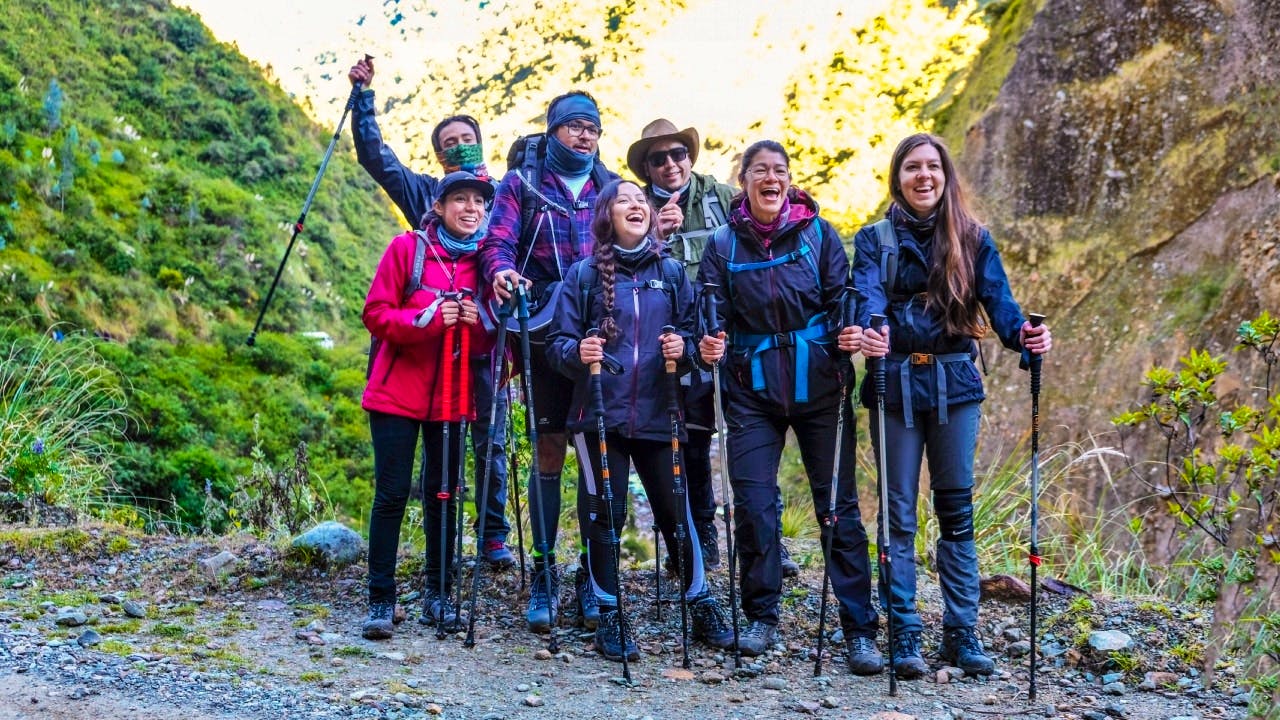How Difficult Is The Salkantay Trek?
The Salkantay Trek is often considered the most challenging path to Machu Picchu. Factors which contribute to the Salkantay trek difficulty include steep inclines and descensions, long hiking hours, varying weather and the risk of altitude sickness.
But not to worry! This route is worth the effort and we’re here to tell you everything you need to know to be prepared for the challenge.

Salkantay Trek Difficulty: Looking at the Factors
Altitude
The Salkantay path has the highest elevations out of all the treks to Machu Picchu. It is said that religious leaders used this path as the increased altitude was thought to offer a more spiritual journey, bringing the traveller closer to the heavens.
The risk when tackling a higher altitude is altitude sickness: a condition that manifests through symptoms such as headaches, nausea, dizziness, and fatigue, and can easily ruin your experience.
Taking the necessary time to acclimatise is important!
The highest point of this trek is on the Salkantay Pass, at a whopping 4,360 metres above sea level. And, you tackle this portion of the trek on day 2 of the hike. This is why we suggest first spending a few days in Cusco, since it sits at 3,400 metres. During this period, engage in light activities and short walks around the area to gradually adapt to the altitude.

Often, a guided tour package, like the 8-Day Salkantay Trek with Skyhook, will include a day or two in Cusco for this very reason. But if you book a package that includes only the hiking, such as the 5-Day Salkantay Trek we still recommend arriving in Cusco a day or two early.
Staying hydrated, taking it slowly and ensuring you are breathing deeply to get the oxygen you need will all help avoid symptoms of altitude sickness. If symptoms do arise, communicate this with your guide or group and take appropriate action, which may include descending to a lower altitude.
Altitude sickness can become serious if not dealt with. Don’t ignore symptoms.


Latest Deals
The Terrain and Distance
The terrain on the Salkantay Trek is challenging, with rugged and steep paths.
The steep descents can be just as tricky as steep inclines. Make sure you are prepared for the terrain by wearing good hiking boots with solid ankle support and grip. Trekking poles will particularly help ease the strain of descents.
The nature of the terrain and distance of the trek (74 km / 46 miles) will have you hiking for 6-8 hours per day. Being physically prepared for endurance will help exponentially. Start a fitness regime well in advance, focusing on cardiovascular workouts and strength training, particularly targeting your legs and core, to build the endurance needed for this demanding adventure.

The Weather and Climate
Both the climate and the weather can vary significantly on the Salkantay route, as it passes through many different types of terrains and levels of altitude.
To stay comfortable, layer your clothing, ensuring you have waterproof and windproof jackets to adapt to shifts in weather. Don't forget a high-quality sleeping bag and thermal layers for chilly nights, alongside a waterproof backpack cover. High altitudes intensify UV rays, so arm yourself with sunscreen, sunglasses, and a hat to fend off sunburn. Check out our Salkantay trek packing list to see what else you should bring.
Even if you’ve been blessed with the best weather forecast possible, night one will have your teeth jittering due to the higher altitude. If you want a decent night’s rest, don’t leave your warm options in Cusco!
You may also like: Weather in Machu Picchu

Nutrition and Hydration
Ensuring you're well-nourished and hydrated is vital on any multi-day hike, and is particularly important on your Salkantay trek due to the exertion at high altitudes. Aim for meals rich in carbohydrates, proteins, and fats to keep your energy consistent.
For on-the-go refuelling, pack high-energy snacks such as nuts, dried fruits, and energy bars, with Kiwicha bars being a great choice. It's also crucial to have safe drinking water, so include water purification tablets or a filter in your gear.
Additionally, you can add electrolytes to your water to keep you sharp and avoid cramping. They also aid in maintaining your body’s fluid levels, making them useful for maintaining good hydration.

Conclusion
Now that we have covered all the factors that shape the Salkantay Trek difficulty, you can see that it is undeniably a challenge, yet it's entirely achievable with the right preparation.
With our tips on gear, nutrition, and acclimatisation, you're setting yourself up for success.
Remember, it's not just about reaching Machu Picchu but enjoying the journey there. This route is praised for its beauty. With balanced meals, proper hydration, and the right footwear, you'll navigate the trek's demands comfortably.
So, lace up your boots and embark on this unforgettable journey with Skyhook!
More Articles:
Other Routes to Machu Picchu:
Find your next adventure
Why Skyhook?
Join over 27,000 Skyhook adventurers who've used our platform to book directly with our vetted local guides, at local prices (we never markup).
Expert Local Guides
Experienced local guides, handpicked by us.
Best Prices
Never pay a markup on the local guide's price.
Exclusive Club
Earn loyalty rewards every time you travel.
Great Social Vibes
Small group tours provide a richer experience.
Stellar Feedback
Over 2,800 reviews, average of 4.9/5 stars.












